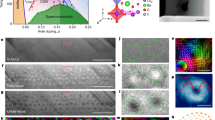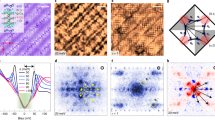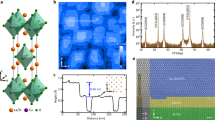Abstract
Granular superconductivity occurs when microscopic superconducting grains are separated by non-superconducting regions; Josephson tunnelling between the grains establishes the macroscopic superconducting state1. Although crystals of the copper oxide high-transition-temperature (high-Tc) superconductors are not granular in a structural sense, theory suggests that at low levels of hole doping the holes can become concentrated at certain locations resulting in hole-rich superconducting domains2,3,4,5. Granular superconductivity arising from tunnelling between such domains would represent a new view of the underdoped copper oxide superconductors. Here we report scanning tunnelling microscope studies of underdoped Bi2Sr2CaCu2O8+δ that reveal an apparent segregation of the electronic structure into superconducting domains that are ∼3 nm in size (and local energy gap <50 meV), located in an electronically distinct background. We used scattering resonances at Ni impurity atoms6 as ‘markers’ for local superconductivity7,8,9; no Ni resonances were detected in any region where the local energy gap Δ > 50 ± 2.5 meV. These observations suggest that underdoped Bi2Sr2CaCu2O8+δ is a mixture of two different short-range electronic orders with the long-range characteristics of a granular superconductor.
This is a preview of subscription content, access via your institution
Access options
Subscribe to this journal
Receive 51 print issues and online access
$199.00 per year
only $3.90 per issue
Buy this article
- Purchase on Springer Link
- Instant access to full article PDF
Prices may be subject to local taxes which are calculated during checkout




Similar content being viewed by others
References
Simánek, E. Inhomogeneous Superconductors: Granular and Quantum Effects (Oxford Univ. Press, New York, 1994).
Gor'kov, L. P. & Sokol, A. V. Phase stratification of an electron liquid in the new superconductors. JETP Lett. 46, 420–423 (1987).
Zaanen, J. & Gunnarsson, O. Charge magnetic domain lines and the magnetism of high-Tc oxides. Phys. Rev. B 40, 7391–7394 (1989).
Emery, V. J., Kivelson, S. A. & Lin, H. Q. Phase separation in the t-J model. Phys. Rev. Lett. 64, 475–478 (1990).
Emery, V. J. & Kivelson, S. A. Frustrated electronic phase separation and high-temperature superconductors. Physica C 209, 597–621 (1993).
Hudson, E. W. et al. Interplay of magnetism and high-Tc superconductivity at individual Ni impurity atoms in Bi2Sr2CaCu2O8+δ. Nature 411, 920–924 (2001).
Flatté, M. E. Nickel probes superconductivity. Nature 411, 901–903 (2001).
Flatté, M. E. Quasiparticle resonant states as a probe of short-range electronic structure and Andreév coherence. Phys. Rev. B 61, R14920–R14923 (2000).
Kruis, H. V., Martin, I. & Balatsky, A. V. Impurity-induced resonant state in a pseudogap state of a high-Tc superconductor. Phys. Rev. B 64, 054501-1–054501-4 (2001).
Liu, J.-X., Wan, J.-C., Goldman, A. M., Chang, Y. C. & Jiang, P. Z. Features of the density of states of high-Tc superconductors probed by vacuum tunneling. Phys. Rev. Lett. 67, 2195–2198 (1991).
Chang, A., Rong, Z. Y., Ivanchenko, Y. M., Lu, F. & Wolf, E. L. Observation of large tunneling-conductance variations in direct mapping of the energy gap of single-crystal Bi2Sr2CaCu2O8-x. Phys. Rev. B 46, 5692–5698 (1992).
Cren, T. et al. Influence of disorder on the local density of states in high-Tc superconducting thin films. Phys. Rev. Lett. 84, 147–150 (2000).
Howald, C., Fournier, P. & Kapitulnik, A. Inherent inhomogeneities in tunneling spectra of Bi2Sr2CaCu2O8-x crystals in the superconducting state. Phys. Rev. B 64, 100504-1–100504-4 (2001).
Cren, T., Roditchev, D., Sacks, W. & Klein, J. Nanometer scale mapping of the density of states in an inhomogeneous superconductor. Europhys. Lett. 54, 84–90 (2001).
Pan, S. H. et al. Microscopic electronic inhomogeneity in the high-Tc superconductor Bi2Sr2CaCu2O8+x. Nature 413, 282–285 (2001).
Ovchinnikov, Y. N., Wolf, S. A. & Kresin, V. Z. Intrinsic inhomogeneities in superconductors and the pseudogap phenomenon. Phys. Rev. B 63, 064524-1–064524-6 (2001).
Ghosal, A., Randeria, M. & Trivedi, N. Inhomogeneous pairing in highly disordered s-wave superconductors. Phys. Rev. B 65, 014501-1–014501-13 (2002).
Burgy, J., Mayr, M., Martin-Mayor, V., Moreo, A. & Dagotta, E. Colossal effects in transition metal oxides caused by intrinsic inhomogeneities. Phys. Rev. Lett. 87, 277202-1–277202-4 (2001).
Wang, Z., Engelbrecht, J. R., Wang, S., Ding, H. & Pan, S. H. Inhomogeneous d-wave superconducting state of a doped Mott insulator. Preprint cond-mat/0107004 at 〈http://xxx.lanl.gov〉 (2001); Phys. Rev. B 65, (2002) (in the press).
Martin, I. & Balatsky, A. V. Doping-induced inhomogeneity in high-Tc superconductors. Physica C 357–360, 46–48 (2001).
Wang, Q.-H., Han, J. H. & Lee, D.-H. Pairing near the Mott insulating limit. Phys. Rev. B 65, 054501-1–054501-4 (2002).
Phillips, J. C. & Jung, J. Nanodomain structure and function of high-temperature superconductors. Phil. Mag. B 81, 745–756 (2001).
Deutscher, G. & Müller, K. A. Origin of superconductive glassy state and extrinsic critical currents in high-Tc oxides. Phys. Rev. Lett. 59, 1745–1747 (1987).
Corson, J., Orenstein, J., Oh, S., O'Donnell, J. & Eckstein, J. N. Nodal quasiparticle lifetime in the superconducting state of Bi2Sr2CaCu2O8+δ. Phys. Rev. Lett. 85, 2569–2572 (2000).
Barabash, S., Stroud, D. & Hwang, I.-J. Conductivity due to classical phase fluctuations in a model for high-Tc superconductors. Phys. Rev. B 61, R14924–R14927 (2000).
Loram, J. W., Luo, J. L., Cooper, J. R., Liang, W. Y. & Tallon, J. L. The condensation energy and pseudogap energy scale of Bi:2212 from the electronic specific heat. Physica C 341–348, 831–834 (2000).
Takigawa, M. & Mitzi, D. B. NMR studies of spin excitations in superconducting Bi2Sr2CaCu2O8+x single crystals. Phys. Rev. Lett. 73, 1287–1290 (1994).
Fong, H. F. et al. Neutron scattering from magnetic excitations in Bi2Sr2CaCu2O8+x. Nature 398, 588–591 (1999).
Vobornik, I. et al. Alternative pseudogap scenario: Spectroscopic analogies between underdoped and disordered Bi2Sr2CaCu2O8+x. Phys. Rev. B 61, 11248–11250 (2000).
Krasnov, V. M., Kovalev, A. E., Yurgens, A. & Winkler, D. Magnetic field dependence of the superconducting gap and the pseudogap in Bi2212 and HgBr2-Bi2212, studied by intrinsic tunneling spectroscopy. Phys. Rev. Lett. 86, 2657–2660 (2001).
Suzuki, M. & Watanabe, T. Discriminating the superconducting gap from the pseudogap in Bi2Sr2CaCu2O8+x by interlayer tunneling spectroscopy. Phys. Rev. Lett. 85, 4787–4790 (2000).
Acknowledgements
We thank A. V. Balatsky, E. Dagotto, M. E. Flatté, S. A. Kivelson, V. Z. Kresin, R. B. Laughlin, J. W. Loram, D.-H. Lee, P. A. Lee, I. Martin, D. K. Morr, S. H. Pan, D. Pines, D. J. Scalapino, Z.-X. Shen, N. Trivedi and S. A. Wolf for discussions and communications. This work was supported by the LDRD program of Lawrence Berkeley National Laboratory, by the ONR, by the CULAR program of Los Alamos National Laboratory, by the Miller Research Foundation (J.C.D.), by IBM (K.M.L.), by Grant-in-Aid for Scientific Research, by a COE grant from the Ministry of Education, and by an International Joint Research Grant from NEDO (Japan).
Author information
Authors and Affiliations
Corresponding author
Rights and permissions
About this article
Cite this article
Lang, K., Madhavan, V., Hoffman, J. et al. Imaging the granular structure of high-Tc superconductivity in underdoped Bi2Sr2CaCu2O8+δ. Nature 415, 412–416 (2002). https://doi.org/10.1038/415412a
Received:
Accepted:
Issue Date:
DOI: https://doi.org/10.1038/415412a
This article is cited by
-
Low-Field Hall effect, Pseudogap and Magnetic Textures in the Bi\(_{2}\)Sr\(_{2}\)CaCu\(_{2}\)O\(_{8+x}\) Superconductor
Journal of Superconductivity and Novel Magnetism (2024)
-
Structural, electrical and mechanical properties of the (NdFeO3)x/(CuTl)-1223 superconductor phase
Applied Physics A (2023)
-
Film-thickness-driven superconductor to insulator transition in cuprate superconductors
Scientific Reports (2020)
-
Polarized Time-Resolved Spectroscopy of Electronic Phase Separation in a Dimer-Mott Organic Insulator
Journal of Superconductivity and Novel Magnetism (2020)
-
Charge-stripe crystal phase in an insulating cuprate
Nature Materials (2019)
Comments
By submitting a comment you agree to abide by our Terms and Community Guidelines. If you find something abusive or that does not comply with our terms or guidelines please flag it as inappropriate.



